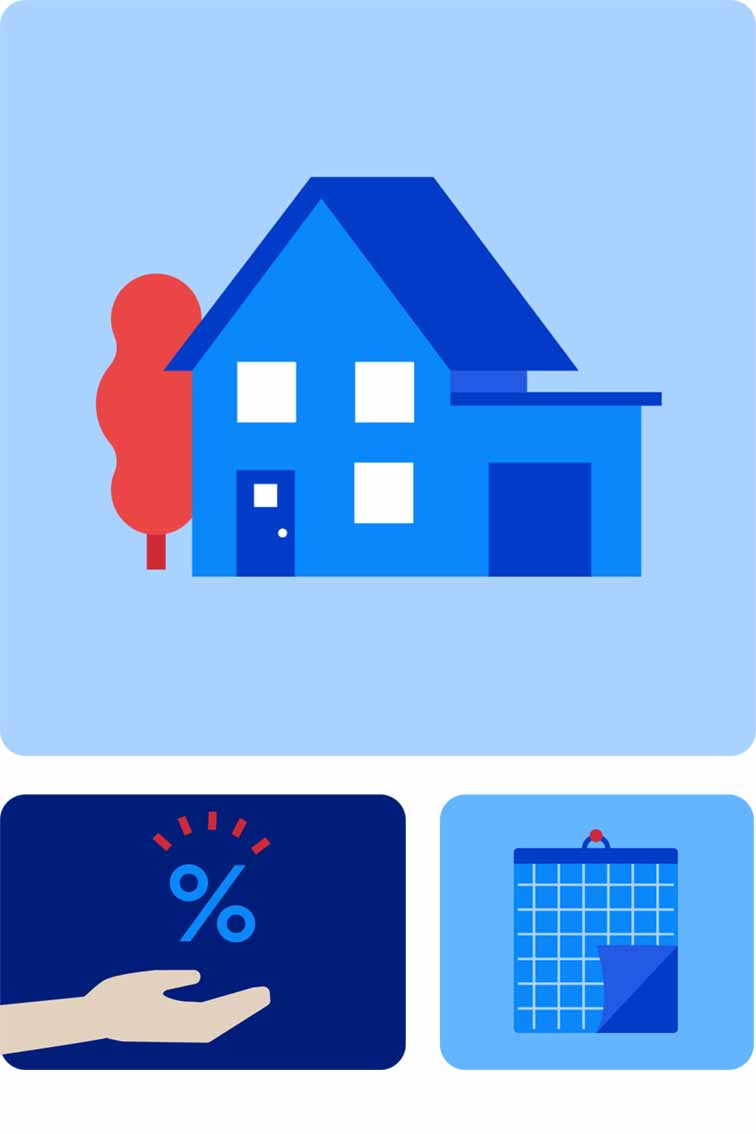You could benefit if current interest rates are lower than when you acquired your mortgage. You might also qualify for a better rate if your personal debt has decreased, or if your credit has improved.
What is a rate-and-term refinance?
A rate-and-term refinance can also be called a traditional refinance or a no-cash-out refinance. Whatever you call it, a rate-and-term refinance is a loan option that may lower your monthly payment or help you pay off your home sooner. Changing interest rates, an increase in home or investment property value or an improved credit score are all reasons to choose rate-and-term refinancing.
When you refinance, you may be able to shorten the length of your mortgage loan term to build equity faster or pay off your home quicker. Or you may be able to extend your loan term and benefit from a lower monthly payment. We offer a range of loan terms for rate-and-term refinancing.
When you refinance, you may be eligible to change the type of loan you have. For instance, if you have an adjustable-rate mortgage (ARM) reaching the end of its fixed period, refinancing to a conventional fixed-rate loan may give you more predictability.
With a rate-and-term refinance, the principal remaining from your previous mortgage stays the same as long as you pay your closing costs up front. This means you can continue to build the equity in your home – which is great news! A rate-and-term refinance is different from a cash-out refinance in that it doesn’t pull funds from the equity in your home.
Compare your refinance loan options.
Here are some of our popular options for a rate-and-term refinance. Or you can compare all loans and rates.
Conventional fixed-rate refinance loans
Why it may be right for you:
- Keeps the same interest rate for the life of the loan
- Rate consistency can help with budgeting
- You plan to stay in the home for a long time
Adjustable-rate mortgage (ARM) refinance loans
Why it may be right for you:
- Initial ARM rates are lower than comparable fixed-rate loans
- Initial rate periods last 5–10 years, and then rates can adjust up or down
- You plan to move within the next few years
FHA refinance loans
Why it may be right for you:
- Keeps the same interest rate for the life of the loan
- Down payments can be lower
- Qualification guidelines are more flexible than other loans
Requirements and qualifications for a rate-and-term refinance.
Credit score – The minimum credit score needed for some mortgages is around 620. Government-backed mortgages like Federal Housing Administration (FHA) loans typically have lower credit requirements than conventional fixed-rate loans and adjustable-rate mortgages (ARMs).
Home equity – As a general rule, you should have at least 20% equity in your home before refinancing. If you have less than 20%, you may be able to refinance, but you may also be required to pay private mortgage insurance (PMI). Then again, if your home value has increased or you have 20% or more equity in your home, a rate-and-term refinance could help you eliminate PMI.
Closing costs – If you refinance, you’ll be required to pay closing costs similar to when you purchased your home. While closing costs vary, you should expect to pay between 2% and 5% of the loan amount. So, on a $250,000 home loan, you could pay between $5,000 and $12,500 in closing costs. You may be able to roll these costs into your new mortgage, but it will increase the principal you must repay.
Looking for other refinance and loan options?
Cash-out refinance
Access to cash at closing
- Replaces your existing mortgage
- Creates new mortgage terms
- Has closing costs similar to first mortgage
Home equity loan
Better for one-time expenses
- Fixed interest rates
- A predictable repayment schedule
- Terms up to 30 years.4
Home equity line of credit
Better for ongoing access to funds5
- Rates typically lower than credit cards
- Flexible repayment options
- The option to lock in a fixed rate


